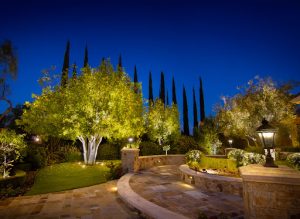Landscape lighting, also known as garden lighting, refers to the application of illumination to public outdoor spaces, gardens, and private properties. These types of lights can be installed on paths, walkways, driveways, and even on the corners of yards to enhance their visibility and safety. There are basically two lighting objectives that most landscape lighting designers focus on.
 One objective is to enhance the look and feel of the yard, patio, garden, or other outdoor space. This can be achieved through indirect lighting effects, moon lighting effects, or straight bright lighting effects. Indirect lighting effects are commonly referred to as “soft lighting”. Moon lighting effects are used when the light source is at a 45 degree angle to the sun so that the moonlight is reflected and refracted back into the light fixture, creating soft lighting.
One objective is to enhance the look and feel of the yard, patio, garden, or other outdoor space. This can be achieved through indirect lighting effects, moon lighting effects, or straight bright lighting effects. Indirect lighting effects are commonly referred to as “soft lighting”. Moon lighting effects are used when the light source is at a 45 degree angle to the sun so that the moonlight is reflected and refracted back into the light fixture, creating soft lighting.
The second objective of landscape lighting design is to create an intimate setting that allows you to spend more time indoors with your family. In this type of design, the landscape lighting fixture is placed in such a way that it accentuates the specific focal point in the yard such as a statue, fountain, water feature, tree, garden flower, or architectural feature. This specific fixture is typically placed near the entrance or exit of a building or near a secluded entryway. A secluded entryway is a great place to install a landscape lighting design because the light will be provided throughout the day and will not disturb or interrupt the quiet of the evening. A focused light source at the entrance or exit of a building is much more difficult to design than one which is located anywhere else in the yard.
A third objective of landscape lighting design is to create a certain level of safety and security in the yard. This can be done by using spotlights or low-voltage spotlights in the yard to highlight an object or area of the yard that is not visible from the street. A low-voltage spotlight only needs to be turned on for a few hours a day to provide enough light to highlight a certain area. Sometimes, homeowners like to use a spotlight to illuminate trees, shrubs, beds, or other landscaping features that they want to add beauty to. The spotlights do not need to be turned on all the time to illuminate these objects because their bulbs will turn on automatically when the sun goes down.
One more objective of landscape lighting design is to prevent or reduce the dangers of falling objects. Low-voltage spotlights are perfect for uplighting high objects such as palms trees, statues, fountains, and other landscaping features that can provide great visual interest and dramatic drama. However, they can also pose a hazard if there are small children around. For this reason, low-voltage uplights designed for use around children are designed with larger gap between the bulb and the lens to prevent small hands from touching the bulb. Spotlights that use a lower voltage for uplighting purposes are perfect for landscaping around a pool or water fountain. These fixtures will not cause any shadow since the light from them is so bright.
Whatever type of landscape lighting design that you prefer, it is important that you consider the safety and security of your outdoor space. There are ways of ensuring that your garden lighting and other outdoor space are safe and functional. It is always a good idea to secure all of your outdoor landscape lighting and other outdoor elements such as walkways, steps, gazebos, patios, decks, and pool surrounds. This ensures that you are not left worrying about your outdoor space and what may happen while you are out of town. For a custom good landscape lighting design visit https://www.southfloridalightingdesign.com/tampa-fl/.
